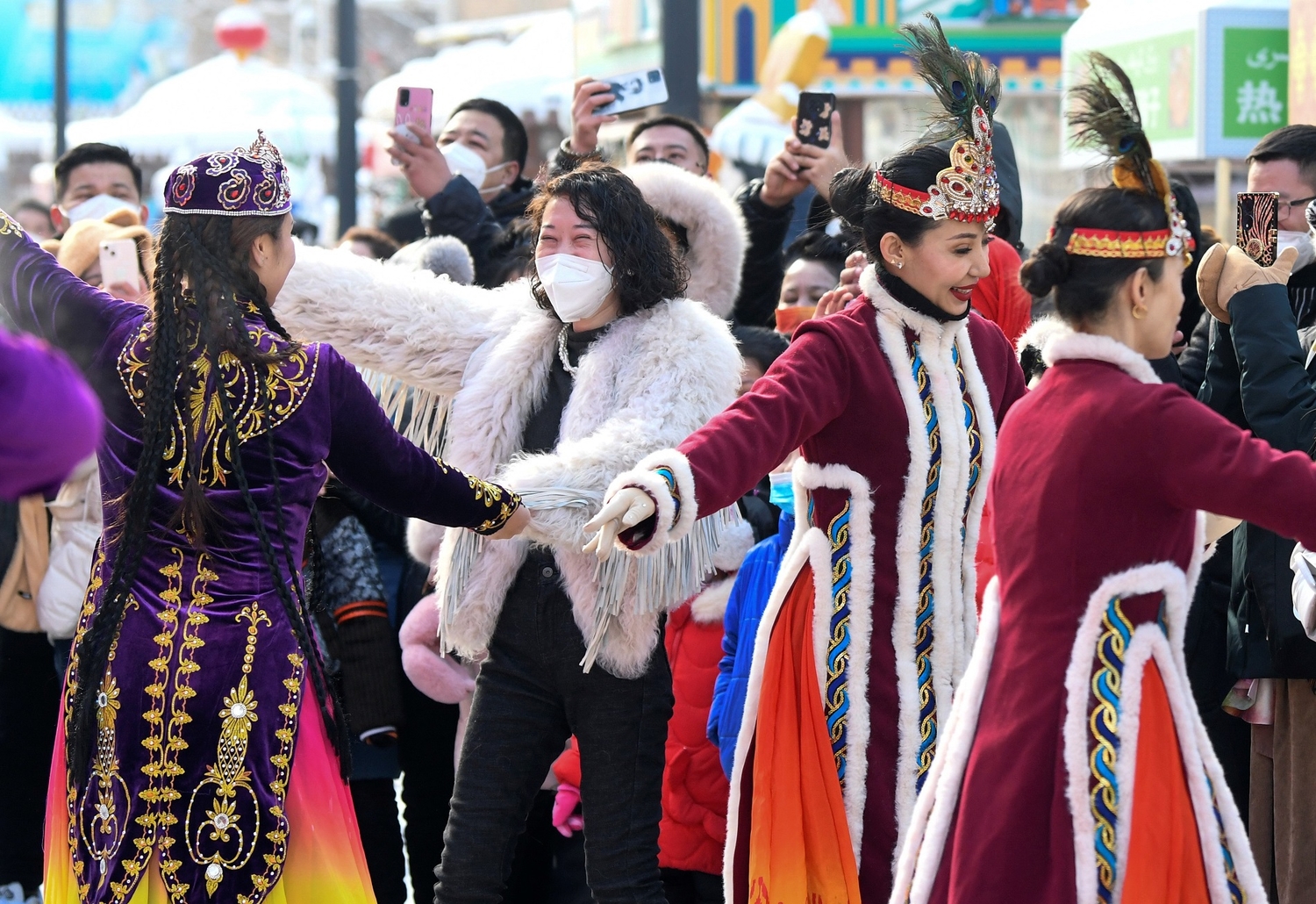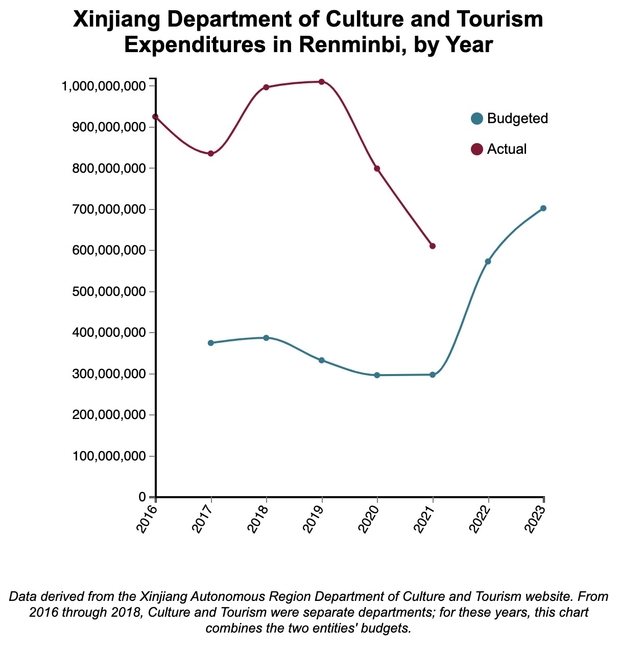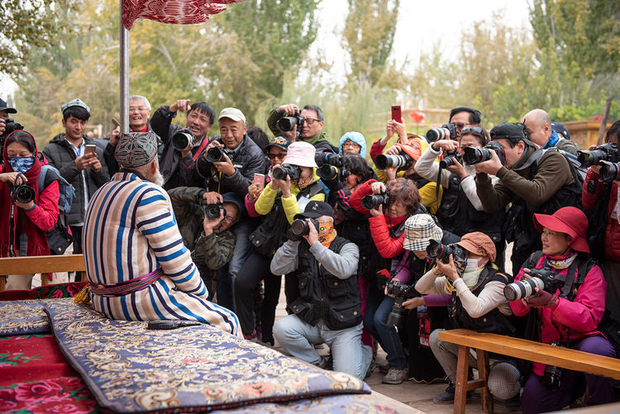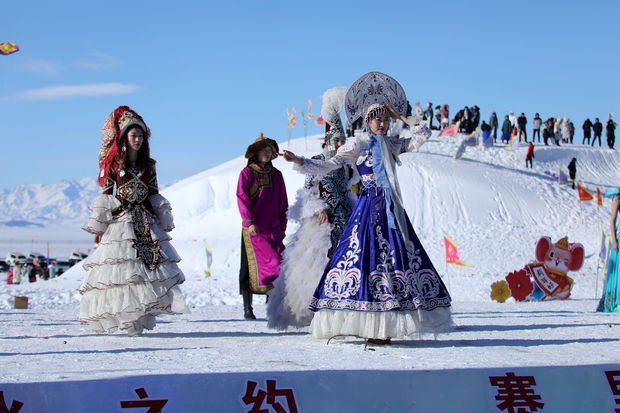In a county where authorities ran multiple internment camps in China’s northwest Xinjiang region, the local government has commissioned a new set of buildings for a very different demographic: tourists.
Beige and decorated with red latticework, the buildings are part of a “cultural tourism industrial park” located in a village in Yutian (Keriye) county, part of an area known for jade that sits at the edge of Xinjiang’s vast Taklamakan desert. The park, which opened in February, offers a hodgepodge of tourist experiences ranging from orchards where visitors can pick fruit for fun to a shopping street showcasing local specialty goods, such as Uyghur medicine made out of licorice root and other plants, and cultural exhibits, like one dedicated to naan, a type of flat bread eaten around Xinjiang. The park is named after Kurban Tulum, a local Uyghur often pictured shaking hands with Mao Zedong on posters around Xinjiang.
North of Yutian, by the red rocks of the Tomur Grand Canyon, fake dinosaurs loom above travelers as part of a sprawling tourism zone replete with an outdoor shooting range and, in a separate area, a walled city with costumed dancers and actors performing historical scenes. In Wushi (Uchturpan) county, which borders Kyrgyzstan, a ski resort with bumper cars, water slides, and amusement park rides for warmer seasons welcomes visitors from all around the country. And in Fuhai (Burultoqay) county in Xinjiang’s northernmost prefecture of Altay, the local government has commissioned trains to transport tourists from Heilongjiang, a province 9,000 kilometers (5,600 miles) away at the northeastern tip of China, to scenic spots in Altay.
These sites and services, which were commissioned, opened, or expanded during the pandemic, are all part of the Xinjiang government’s efforts to promote tourism across Xinjiang. Last year, the government completed a stretch of more than 2,700 kilometers of railroad tracks encircling the Taklamakan desert, a circuit aimed at improving the local economy, including by offering special rail services that target tourists.
Growing the region’s tourism sector isn’t a new goal for Xinjiang authorities, who have long recognized the commercial potential in monetizing the region’s sweeping landscapes and natural beauty. However, the funding allocated to tourism has grown significantly this year and last year—even as China’s zero-COVID policies caused a drop in inbound tourists to Xinjiang.
The Xinjiang government’s efforts to expand tourism and the resulting uptick in spending are an important part of what appears to be a new stage in Beijing’s strategy to secure control over Xinjiang and reshape the region’s culture and inhabitants to resemble the Han-dominant parts of the country.
In government procurement documents and Chinese state media, tourism is presented as a way to “culturally replenish” Xinjiang with traditions and customs from other parts of China, as well as a channel for instilling in local residents a unitary Chinese identity. And as foreign reporting on the region declines, tourism is becoming ever more important and influential in shaping how people outside of the region view Xinjiang, especially after more than five years of draconian policies including mass internment and incarceration.
According to official figures, in 2022, the Xinjiang Department of Culture and Tourism increased its spending budget by more than 90 percent compared to the year prior. This year, the department is planning to spend 701 million renminbi, or more than double the planned budget in 2019.
Of course, the department could end up underspending its budget, and figures on how much money was actually spent in 2022 and 2023 have not yet been released. But given that Xinjiang’s culture and tourism authorities have consistently spent more than they project, according to available data dating back to 2013, it is likely that expenditures for this year and last year will be higher than planned.
The Xinjiang government’s increasing efforts to open the region to both domestic and international tourists stand in stark contrast with the government’s campaign of repression directed at Uyghurs and other local ethnic groups, which, since at least 2017, has included mass internment, systematic destruction of religious and cultural sites, and surveillance programs such as biometric data collection and regular house visits by Party cadres.
Images of Xinjiang as a tourist idyll by Chinese media, paid influencers, and visitors have formed a central part of the Chinese government’s response to rights activists, scholars, and journalists who have reported on the region’s mass internment of ethnic minorities using government documents, satellite imagery, and interviews from detainees and their family members.
Last year, Xinjiang government spokesperson Xu Guixiang explicitly portrayed tourism as an effective tool to combat critical coverage of the region, which he derided as “smearing.” “Tourism in Xinjiang is booming,” said Xu at a press conference last July. “Everyone praises Xinjiang’s economic and social development and the happy lives of the people.”
“More and more people have fallen in love with Xinjiang and see through the plots and tricks” of Western anti-China forces, he added, calling this a “powerful counterattack to the anti-China forces in the U.S. and the West.”
The expansion of Xinjiang’s tourism industry also comes as the region’s politics undergo a fundamental shift, with hardliner Chen Quanguo, who directed the roll-out of the region’s re-education camps and an omnipresent surveillance and police apparatus, stepping down in 2021 to make way for the region’s new Party Secretary, Ma Xingrui, a technocrat who took the position after serving as governor of the business-friendly province of Guangdong.
That change, along with foreign media reports in 2021 and 2022 about the closure of several re-education facilities, appears to follow a leaked five-year plan the Chinese government had for Xinjiang. According to a 2018 speech by Minister of Public Security Zhao Kezhi, Xinjiang was supposed to enter a stage of “comprehensive stability” by 2021, following earlier phases of stabilizing, consolidating, and normalizing social stability, starting in 2017.
“We’re definitely in a new phase now,” says Rachel Harris, a professor at the School of Oriental and African Studies, University of London.
This new phase, which includes not only the closure of some re-education camps, but the movement of some camp detainees into factories and prisons, started a few years ago, says Harris, who studies intangible cultural heritage from China and Central Asia, including that of Uyghurs.
“And then we saw a massive push to kickstart tourism again,” she says, an initiative that seems designed to tie the region more closely to the rest of China and promote the narrative that “Chinese culture has many tributaries, but there’s basically just one river of Chinese culture.”
* * *
‘Replenishing Xinjiang Culture’
Prior to the pandemic, the number of tourists in Xinjiang had increased every year since 2014, when a spate of violent attacks in Xinjiang and other parts of China that authorities blamed on religious extremists prompted the local government to declare a “People’s War on Terror.” This “war,” which expanded surveillance of the region’s mostly-Muslim ethnic minorities, preceded the internment of some one million people beginning in 2017, some for simply contacting overseas relatives, traveling abroad, or having WhatsApp on their phones.
From the perspective of Xinjiang officials, however, such policies—which some countries including the United States have in recent years described as contributing to genocide—have created the desired stability to attract more tourists.
“Abundant tourism resources are an important factor in attracting tourists, but what is more important is the stable social environment in Xinjiang,” said Shohrat Zakir, now the former chairman of Xinjiang, at a press conference in March 2018. “After these two years of hard work, Xinjiang’s overall situation is very stable . . . and the good social situation has advanced the development of the tourism industry,” he said.
The Xinjiang government’s promotion of tourism is also aligned with Beijing’s political and ideological goals of instilling a sense of patriotism in ethnic minorities, many of whom live in border regions like Xinjiang, Inner Mongolia, and Yunnan, and inducing them to embrace a unitary Chinese identity, instead of strongly identifying with a distinct culture or ethnic background.
Using tourism to further this goal is something government officials have explicitly emphasized in public speeches. In 2022, the People’s Daily described Xu Ruijun, head of the Xinjiang Department of Culture and Tourism, as saying that his department did a good job of “telling the story of China’s Xinjiang.”
This year, moreover, the region’s culture and tourism work must “firmly grasp the central theme of forging a shared consciousness of Chinese nationality.”
The framing of tourism as a means for promoting cultural assimilation echoes the language of the “cultural replenishment of Xinjiang” (文化润疆, wenhua run jiang), a term the Party describes as “passing on the genes of Chinese culture,” promoting traditional Chinese culture, facilitating cultural exchanges between Xinjiang and the rest of the country, and creating a “shared consciousness” of the Chinese nationality, according to Communist Party journal Qiushi.
In 2020, Xi Jinping himself invoked this concept at a government conference on Xinjiang affairs, imploring officials to “let the shared consciousness of the Chinese nationality take root deep in the soul” and “do a good job in the area of ideology and carry out the project of culturally replenishing Xinjiang.”
In the tourism industry, “cultural replenishment” can mean bringing in cultural products or practices from other parts of China into Xinjiang. Yutian’s industrial park, for example, includes an exhibition of paper cuttings and clay figurines from Tianjin, a city on China’s eastern coast which invested 19 million renminbi in the park’s construction.
Similarly, in Wushi county, according to a government procurement document, the local culture, sports, radio, television, and tourism bureau commissioned exhibits for a museum dedicated to “southern Confucianism,” the branch of Confucianism cultivated by his descendants who moved to Quzhou, eastern Zhejiang province, during the Song dynasty. A Quzhou official touted the southern Confucianism museum as “culturally replenishing Xinjiang,” at the museum’s opening ceremony in November 2021.
As Yan Hua, Party secretary of Wushi county, said at the event, the museum would “inherit and promote Confucian culture” and “raise Wushi county to the peak of excellent Chinese culture.”
Local tourism bureaus have also pursued projects explicitly engaged in ideological education. In Gongliu (Tokkuztara) county in western Xinjiang, the local culture, sports, radio, television, and tourism bureau commissioned a Pomegranate Seed Reading Room in June 2021, according to a government procurement document. According to local Chinese media, the county has over 100 of such reading rooms.
The reading rooms are a place to host classes on Party history, boost political literacy, and “deeply plant love for the Party and love for the country,” according to local media coverage. The “pomegranate seed” name references a slogan on ethnic unity that often appears on posters in Xinjiang and other parts of China: “All ethnic groups must embrace each other tightly like pomegranate seeds.”
While Gongliu has reached its goal of having one Pomegranate Seed Reading Room in each village, according to Chinese media, the county has done away with a very different kind of cultural institution that used to mark each locale: mosques. According to a 2021 report by the Dutch newspaper de Volkskrant, which examined satellite imagery and visited the county, only 12 of the 66 mosques in Gongliu in 2018 were still “intact and in use.”
* * *
Paired Assistance
An important source of funding for the “replenishing” of Xinjiang culture comes from the region’s Paired Assistance program, which links provincial and city governments from the rest of the country with localities in Xinjiang.
“Assistance” through the program can encompass rotations of cadres from outside of Xinjiang into the region and state-owned enterprises’ investing in Xinjiang manufacturing. Conversely, private conglomerates that shift production from other provinces to the northwest region can potentially benefit from land, electricity, and transportation subsidies offered by local Xinjiang governments participating in the Paired Assistance program.
Such initiatives are financed by local governments involved in the program, as well as the central government and state-owned enterprises directly under its management. In 2019, the 19 provinces and cities that aid Xinjiang invested a total of 18.8 billion renminbi into 1,935 Paired Assistance projects targeting poverty alleviation and “improving people’s livelihoods,” according to official news agency Xinhua.
Funding for tourism projects in Xinjiang can fall under the purview of Paired Assistance. The Yutian county cultural tourism industrial park, for instance, was financed at least in part through the Paired Assistance program, linking Tianjin city and Yutian county. The Confucianism museum in Wushi county also received funding through a Paired Assistance partner, this time Quzhou city, the center of southern Confucianism culture in the coastal province of Zhejiang.
Likewise, funding for the Pomegranate Seed Reading Rooms in Gongliu came through a Paired Assistance partnership with Zhangjiagang city in Jiangsu province. According to an article republished by the Gongliu county government in January, 250 million renminbi has come through the Zhangjiagang Paired Assistance program over the last three years.
Cultural and tourism work in Xinjiang should be regarded as “an important political task to be persevered in for the long-term,” said Hu Heping, China’s Minister of Culture and Tourism, on an inspection tour of Xinjiang Paired Assistance work last summer. The tour included watching the premiere of a musical performance titled “Lift up Your Hijab—Xinjiang Is a Good Place” in Urumqi, Xinjiang’s capital.
Among other goals, Paired Assistance work in China should “replenish Xinjiang through culture, revitalize Xinjiang through tourism,” said Hu, and “make new and greater contributions to forging a shared consciousness of the Chinese nationality.”
Between 2015 and 2019, the central government and Xinjiang Paired Assistance provinces and cities invested more than 10 billion renminbi into Xinjiang’s tourism industry alone, according to Chinese state media.
In the end, for locals, projects aimed at advancing the “cultural replenishment of Xinjiang” and the rapid growth of the tourism industry threaten a further flattening of local culture, where lived experiences are turned into objects of touristic consumption, say scholars of the region. For example, government bodies promote song and dance performances while criminalizing other aspects of Uyghur culture, such as prayer or even Uyghur-language literature. The issue with the development of Xinjiang’s tourism industry is that it occurs “against the background of violence against people, involuntary detention, and brutality in the camps,” said SOAS professor Rachel Harris.
Those whose culture and heritage are being used for profit have “no ability to assert their own desires of how their culture and heritage should be represented,” she says. Official representations of Uyghurs are “always extreme and they’re always lacking in nuance”—whether it’s depicting Uyghurs as potential terrorists or as smiling and dancing—and “ignore the diversity of views and normality of people” among the community.
“That is really the key issue: the problem of the right to really own their own culture.”
China’s government is trying to create a tourism experience where Xinjiang is “different enough that it’s worth maybe spending extra for airfare, but not so different where Han Chinese tourists feel out of place,” explains Timothy Grose, a professor at Rose-Hulman Institute of Technology, who studies ethnic policy in China and has conducted fieldwork in Xinjiang.
That includes downplaying Islamic parts of Uyghur culture and minimizing cultural differences to the degree that “it’s just exotic,” he says, “and maybe even a little quaint and romantic.”
Jessica Batke provided research for this article.







